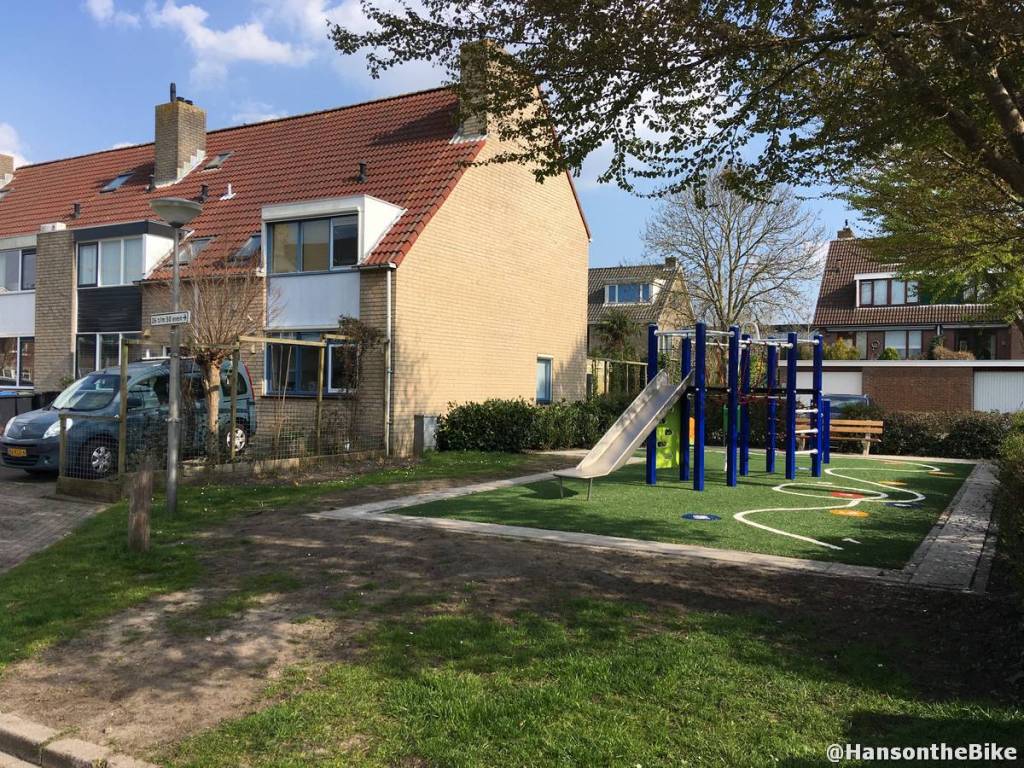
One of the Dutch ‘inventions’ that comes up often when I talk about traffic with Canadians is the “Wooh-nerve”. Initially I wasn’t sure what they were talking about but I soon figured out is about the ‘woon-erf’.

A woonerf is a concept that rose to fame in the 1970’s and 1980’s to force traffic to slow down in residential neighbourhoods, giving the streets back to non motorised vehicles and hopefully to increase social interaction. It was developed by Niek de Boer in Emmen in 1968 for a new neighbourhood and further implemented and adjusted for existing 19th and 20th century streets by Joost Váhl, a student of Mr. De Boer.

Woonerf, koolsla and jacht
The woonerf comes from the Dutch word ‘wonen’ (to live, as in “Ik woon in Canada”, or “Ik woon in een huis”) and the word ‘erf’, which is the area around the farmhouse where chickens roam, the dog guards, the milk cans are cleaned and the wooden shoes scrubbed for Sunday. It is often translated as ‘living street’ in Anglo-Saxon countries. Often though, the word ‘woonerf’ is simply used in English too, following such useful words as ijsberg, stoep, koolsla and jacht. You really do more Dutch then you realise.

What are the characteristics of a woonerf
You’ll recognize a woonerf when you see one. You often see the cute pictures of an olde Dutche streete, with a few pavers taken out, bike racks and trees brought in, a bit ziggy zaggy traffic flow design, a park bench or two. They are usually reconfigures older streets. Woonerven look different in the suburbs as they were designed at the drafting table.

Important characteristics are:
- Speed limit down to 15 kph, initially ‘walking pace’, but that is a bit abstract and fuzzy, hence 15 kph
- Parking only in dedicated places and often not in front of your own house
- Pedestrians can use the entire space (but cannot just jump in front of a car)
- No distinctive sidewalks or ‘car space’, i.e. no curbs
- A distinctive entrance
- Green space, planters, bike racks

A visit to an historic woonerf
Having time on my hands during my visit in the Netherlands, I biked to many places from my youth and this week I turned into my grandmother’s woonerf. I vaguely remembered where she lived but had no clear memory of it anymore. I noticed that after nearly 40 years some parts of the woonerf could use a bit of maintainance.

Is the woonerf disappearing?
But cycling through much newer neighbourhoods of the last say ten years, I noticed no new woonerven (plural) are being built anymore. So I asked Mark Wagenbuur, known as BicycleDutch on social media and website, why that is. He explained to me that the 30 kph zones have basically replaced the woonerf concept under the Sustainable Safety umbrella. What you would see now is rather than one street dedicated as a woonerf off a more regular street, you’ll find an entire neighbourhood with a 30 kph speed limit and several design features to slow traffic down.

Separation of driving and walking again
The 30 kph zones do have a separate part for driving/riding and for walking. The streets can be terribly narrow as I experienced when I had to back up (in a car) when a car came from the other direction. There is dedicated parking though and you will notice drempels (speed humps) both when you enter a 30 km zone and throughout the neighbourhood.

The woonerf is not dead, but from what I see here in Lansingerland, things have changed. I still think it is an awesome concept that should not just fade away. I read an article about a new development in Sion, south of The Hague, which I should visit too as my dad’s roots are there.


Here are some photos to share with you how a woonerf from the 1980’s looks like now. I am adding a screen shot from Google for the bird’s eye view. I also added a post recently about density in Dutch villages and neighbourhoods.


Further reading
Here is a website that is still positive and hopeful about woonerven (In Dutch): Woonerven | MENSenSTRAAT.

the woonerf made sense when streets were only designed for cars, but fortunately most of those engineers have died off. back then a street not just for cars had to be a special place.
now we are supposed to design streets for everyone, but we all know in Ottawa they are designed for cars first and then some features are added to label the street “complete”. It usually looks good on the plans and bad when implemented.
adding some brick pavers to crosswalks or street surfaces only work for a few years before they are patched over with asphalt. We do not maintain nor do city maintenance staff care for any special features.
woonerfs may be the term, but increasingly they are just naked streets with minimal sidewalks or ped separation and like sidewalk-free suburban streets they become seas of asphalt dominated by cars where peds and cyclists are intruders.